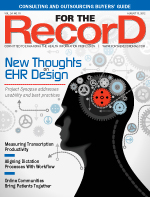 August 13, 2012
August 13, 2012
Coding for Cystic Fibrosis
For The Record
Vol. 24 No. 15 P. 26
Cystic fibrosis is a chronic, progressive, and usually fatal inherited disease, though most patients with the condition live into at least their 30s. Cystic fibrosis causes abnormal mucus glands due to an abnormal function of the cystic fibrosis transmembrane conductance regulator. The secretions from mucus, sweat, and digestive juices become thick and sticky, causing them to plug up the tubes, ducts, and passageways in the digestive system, lungs, and pancreas.
Symptoms
The signs and symptoms of cystic fibrosis vary depending on the severity of the disease. Symptoms in newborns may include delayed growth, failure to gain weight normally (including into childhood), no bowel movements in the first 24 to 48 hours of life, and salty-tasting skin.
Common respiratory symptoms include breathlessness, cardiomegaly, clubbing, collapsed lung, hemoptysis, inability to exercise, nasal polyps, persistent chronic cough that produces sputum and mucus, recurrent lung infections, particularly salty sweat, sinusitis, stuffy nose, and wheezing.
Respiratory infections are very common in patients with cystic fibrosis since bacteria that would normally be removed with the clearing of mucus are trapped. Many of these infections are chronic. Pseudomonas aeruginosa is the most common bacteria agent causing respiratory infections.
Common digestive symptoms include foul-smelling greasy stools, pale or clay-colored stools, poor weight gain/growth, meconium ileus, severe constipation, increased gas or bloating or a swollen belly, nausea, and loss of appetite.
Common Associated Complications
The following conditions are commonly associated with cystic fibrosis: bronchiectasis; chronic sinus and lung infections such as sinusitis, bronchitis, and pneumonia; nasal polyps/sinusitis; hemoptysis; pneumothorax; collapsed lung; cor pulmonale; chronic respiratory failure; nutritional deficiencies/malnutrition; diabetes; blocked bile duct; cholelithiasis; liver disease or liver failure; pancreatitis; biliary cirrhosis; rectal prolapse; intussusception; infertility in men and decreased fertility in women; osteoporosis and arthritis; and electrolyte imbalance.
Cystic fibrosis is classified to ICD-9-CM subcategory 277.0 and includes the following codes:
• 277.00, Cystic fibrosis without mention of meconium ileus;
• 277.01, Cystic fibrosis with meconium ileus;
• 277.02, Cystic fibrosis with pulmonary manifestations;
• 277.03, Cystic fibrosis with gastrointestinal manifestations; and
• 277.09, Cystic fibrosis with other manifestations.
If the patient has both pulmonary and gastrointestinal manifestations, then both 277.02 and 277.03 may be assigned together. Also assign codes for any associated manifestations if specifically documented. However, a secondary code is not required if no specific manifestation is documented.
Sequencing of cystic fibrosis with the documented manifestation or complication depends on the circumstances of admission. If a patient with cystic fibrosis is admitted due to a manifestation or complication, such as pneumothorax or intussusception, the manifestation or complication should be sequenced as the principal diagnosis and cystic fibrosis as the secondary diagnosis. If the physician documents that the admission is due to the cystic fibrosis rather than a manifestation, then the cystic fibrosis will be the principal diagnosis (AHA Coding Clinic for ICD-9-CM, 2002, fourth quarter, pages 45-46).
If a patient with cystic fibrosis is admitted solely for pulmonary cleanout, assign the appropriate code from subcategory 277.0 as the principal diagnosis (AHA Coding Clinic for ICD-9-CM, 1994, third quarter, page 7).
Diagnosis and Screening
A sweat chloride test, which checks for a higher-than-normal amount of salt, is the standard diagnostic test for cystic fibrosis. Immunoreactive trypsinogen is a standard screening test for newborns. Continued monitoring after diagnosis may include imaging (eg, X-rays, CT, MRI), lung function tests, sputum culture, and organ function tests.
Treatment
There is no cure for cystic fibrosis. Treatment will focus on easing symptoms and reducing complications. Treatment goals include preventing and controlling lung infections, loosening and removing mucus from the lungs, preventing and treating intestinal blockage, and providing adequate nutrition.
Coding and sequencing for cystic fibrosis are dependent on the physician documentation in the medical record and application of the Official Coding Guidelines for inpatient care. Also, use specific AHA Coding Clinic for ICD-9-CM and American Medical Association CPT Assistant references to ensure complete and accurate coding.
— This information was prepared by Audrey Howard, RHIA, of 3M Consulting Services. 3M Consulting Services is a business of 3M Health Information Systems, a supplier of coding and classification systems to more than 5,000 healthcare providers. The company and its representatives do not assume any responsibility for reimbursement decisions or claims denials made by providers or payers as the result of the misuse of this coding information. More information about 3M Health Information Systems is available at www.3mhis.com or by calling 800-367-2447.
ICD-10-CM Coding for Cystic Fibrosis
In ICD-10-CM, cystic fibrosis is classified to category E84. Similar to ICD-9-CM, there are specific codes for pulmonary (E84.0) and intestinal manifestations (E84.19). Code E84.19 is also assigned for cystic fibrosis with distal intestinal obstruction syndrome and fecal impaction. Code E84.11 is for meconium ileus in cystic fibrosis. If the meconium ileus is not due to cystic fibrosis, then assign code P76.0. Code E84.8 is for cystic fibrosis with other manifestations, and code E84.9 is assigned for unspecified cystic fibrosis.
— AH



